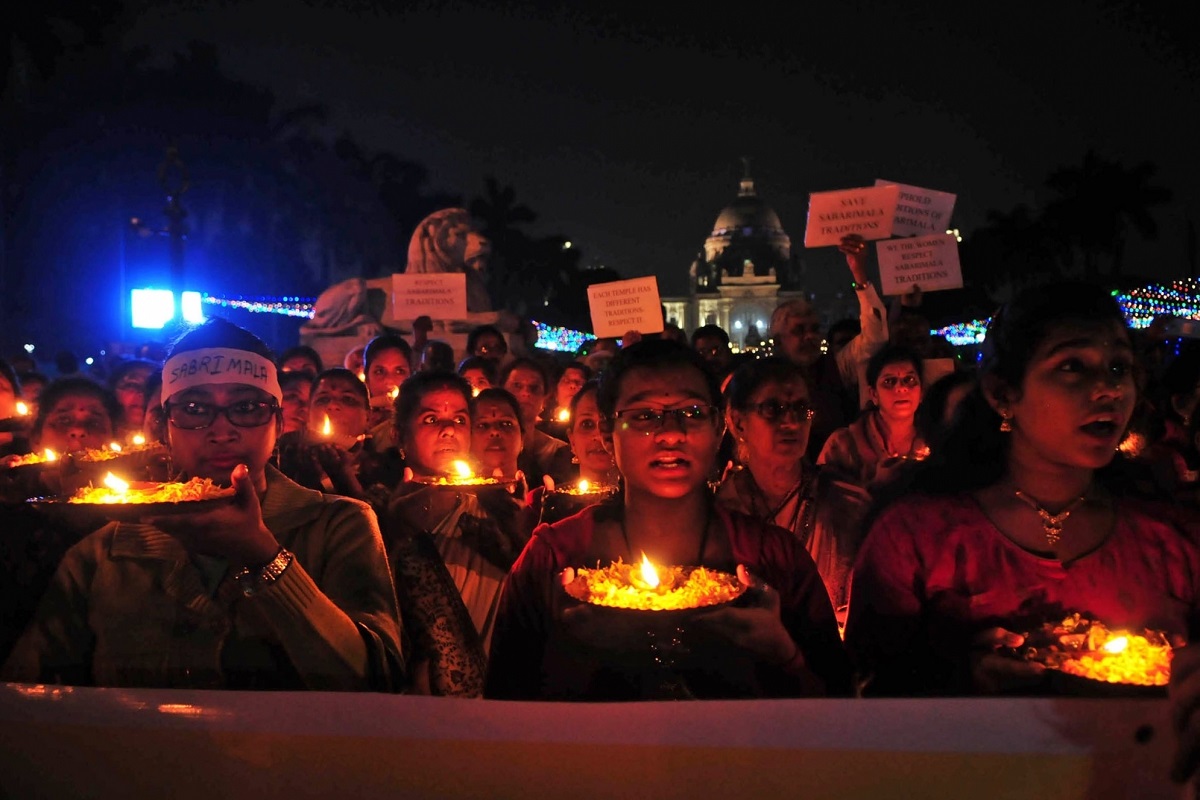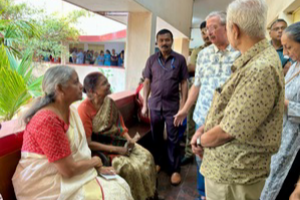The Sabarimala temple, an immensely popular place of pilgrimage, is situated atop the hills of Kerala and is devoted to a Hindu god, Ayyappa. Till recently, the temple was open only to men. There is a police station on the way to the sacred complex where women police personnel can stop women devotees from proceeding, and in case women manage to slip by, the shrine’s security guards will not allow them to enter. It is not only the face that will easily help identify a woman; the pilgrims are traditionally expected to enter the inner sanctum with their chests bare.
Ayyappa is usually considered a celibate god (though in some places, not Sabarimala, he is depicted with wives). In the reckoning of the temple authorities, visits of women of menstruating age could be a distraction on the deity’s path of purity. “Menstruating age” is considered as the period between 10 and 50 years. These limitations, however, ought now to be a closed chapter. On September 28, the Supreme Court ruled that the shrine should open its doors to all women pilgrims, irrespective of their age. While implementation of this ruling could take some time, the temple fund authorities may yield to the judgment as in the case of other Hindu temples.
Sabarimala’s history is as tangled and diverse as Indian history and society itself. Ayyappa is believed to be the son of two other male deities, Shiva and Vishnu, and this unlikely communion was made possible when Vishnu took the female form. Ayyappa is therefore also called Hariharaputra, “the son of Vishnu [Hari] and Shiva [Hara].” Ayyappa, mainly worshipped in southern India, could also have been a pre-Aryan deity, a god worshipped before the culture of the Aryans spread throughout the subcontinent. Later his cult was possibly absorbed into the Aryan pantheon, and, if that assumption is true, the story of Shiva-Vishnu parentage would have to be a later addition.
If that is not diverse enough, the story of Ayyappa also has a Muslim strain within its tapestry. During his life on earth, Ayyappa had to defeat a certain enemy and the struggle was won thanks to the assistance of a crucial ally, a Muslim warrior leader called Vavar. This confluence of Hinduism and Islam in Ayyappa’s cult has been beautifully shown in Yoginder Sikand’s book, The Sacred Spaces: Exploring Traditions of Shared Faith in India. A mosque devoted to Vavar stands near Ayyappa’s main shrine and Hindu pilgrims pay a visit to it before entering the temple. They take sacred water from the mosque’s pond and one of the Muslims officiating in the mosque puts sacred ash on their foreheads while reciting the fatiha (the opening verse of the Quran). It is a rare but fascinating instance of the mingling of Hindu and Islamic mores in contemporary India.
The pre-Aryan and Aryan elements, the cults of Shiva and Vishnu, and the religions of Islam and Hinduism may meet here, but at the same time orthodoxy excludes most women from worshipping in the shrine. Apart from the common explanation about Ayyappa’s celibacy, one myth claims that the god had a female deity waiting for him to marry, and she was made to wait as long there were no more first-time devotees to visit the shrine. This, however, may not be in accord with the perception of Ayyappa’s in eternal celibacy. The issue of restricting sexuality is strongly connected to Ayyappa’s cult. There are definite times and rules to follow while visiting the Sabarimala temple. Among other restrictions, the pilgrims should first undergo a 41-day pious life and abstention from meat and intercourse.
The recent Supreme Court ruling, therefore, is interpreted by many as breaking the walls of strict orthodoxy in this particular tradition. It has been criticised and praised.
Two certitudes that are integral to the Constitution ~ equality and secularism ~ have been brought to bear during this discourse.
The lone dissenting judge on the five-member Bench was a woman, Justice Indu Malhotra. The male judges voted in favour of allowing women to enter the temple. Justice Malhotra observed: “In a secular polity, issues are matters of deep religious faith and sentiment, must not ordinarily be interfered with by courts The court should not interfere unless there is any aggrieved person from that section of religion” or if a tradition is a “pernicious, oppressive, or a social evil.” The judge also pointed out that “what constitutes an essential religious practice is for the religious community to decide.” Such points should certainly be considered, as they lead to a conclusion that in a secular, democratic state, religious orthodoxy should be protected just like other freedoms, as long as such orthodoxy is not oppressive towards other fundamental values.
Secularism, however, is understood differently in India than it is in Europe or the United States. It does not focus on separation of Church and State. In Hinduism, there is no Church to separate from the state, as Donald E. Smith has rightly pointed out in his book on secularism in India. The same more or less applies to Indian Islam as well. While there is more than one interpretation of the idea of secularism in India, it is assumed that the state should treat all religious communities in the same way. It should, in other words, keep an equidistance. But what is a more secular approach ~ A non-interference in the customs of religious communities or interference with them? The paradox of non-interference is that the secular state cannot reform the orthodox traditions that function within it. The paradox of interference is that the secular state, by involving itself in reforming religious traditions, becomes a kind of religious authority itself.
Beyond secularism, another important feature in the Constitution is the equality of all of its citizens. Treating every community the same way may perhaps be understood as following both equality and secularism. But can equality of all citizens be achieved while maintaining the equality of all communities? Equality of religious communities could be interpreted as letting them practise their customs, including barring women from entering religious places. But such equality of communities means the inequality of genders and this applies not only to the issue of women’s entry into temples.
Equidistance of the state from religious communities should mean that either the state interferes in all of their customs in the same way or lets them retain them. Whether one supports the court judgment or not, it should be pointed out that it is a piecemeal legislation. Decades ago, the Indian Republic forced conservative Hindu temples to open their doors to Dalits (untouchables) but the same was not done with regard to shrines that do not admit women (the ruling of the Bombay court in 1950s retained the access rules of Sabarimala).
Sabarimala will now join the list of temples open to women, but there are other Hindu temples that keep their gates shut to them. Moreover, there are possibly even more shrines of Muslim saints (tombs called dargahs) that traditionally disallow women from entering the inner sanctum. In 2016, the Supreme Court similarly forced the famous Haji Ali Dargah to open its doors to women, but the same did not apply to other Islamic shrines. The principle of equidistance has been continuously violated.
Justice Malhotra’s point was that the court should not interfere unless there is “any aggrieved person.” Her approach is legally sound, but this is exactly what leads to piecemeal legislation: Only those religious communities that face legal proceedings can be reformed with state interference. It is, in a way, a moderately conservative approach. There is no change unless somebody demands it. This approach may be legally correct, but it is against the spirit of treating every community and every citizen in the same way.
The judgment was given precisely because there were “aggrieved persons.”
(The writer is with the Eastern Institute for Integrated Learning in Management (EIILM), Kolkata)










